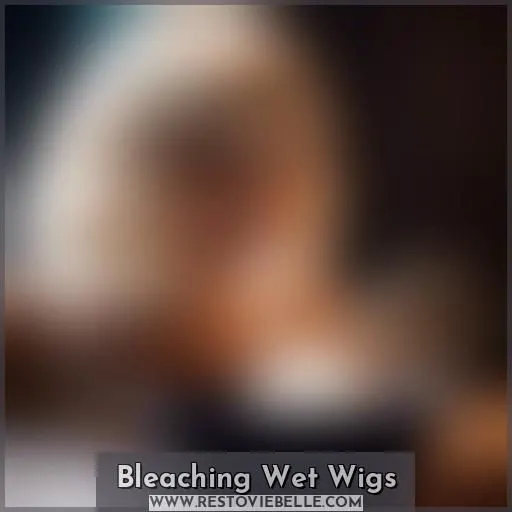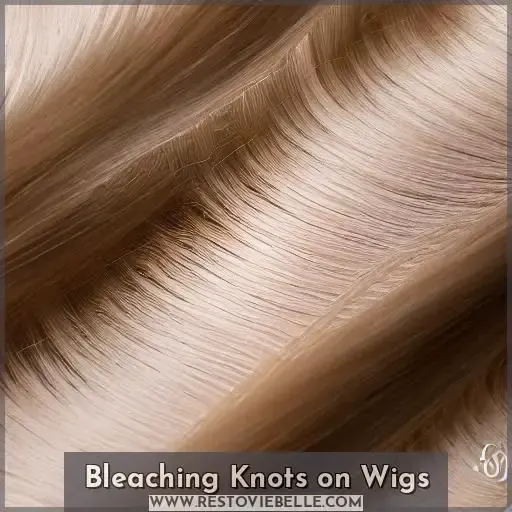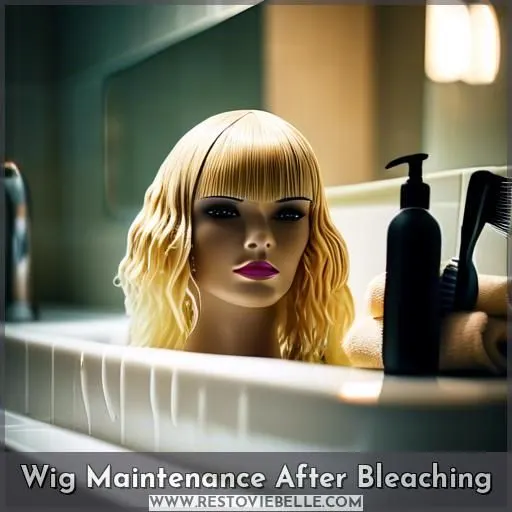This site is supported by our readers. We may earn a commission, at no cost to you, if you purchase through links.

Yes, you can bleach a wet wig, but it requires some extra care and preparation. Towel-dry the hair first to remove excess moisture. Then, use balayage or ombre techniques to apply the bleach, monitoring the processing time closely. Be sure to deep condition the wig after bleaching to restore hydration. Consulting a professional wig stylist is also highly recommended, as they can guide you through the process and guarantee the best possible results.
By following these steps, you can successfully bleach a wet wig and achieve the perfect color. However, the story doesn’t end there. Proper aftercare and maintenance are crucial to keeping the wig in top condition.
Table Of Contents
Key Takeaways
- Bleaching a wet wig is possible but requires careful preparation, such as towel-drying the wig to remove excess moisture before applying bleach.
- Utilizing balayage or ombre techniques during the bleaching process can help achieve a natural-looking, sun-kissed effect while minimizing damage.
- After bleaching, it’s crucial to deep condition the wig to restore hydration and maintain its health and vibrancy.
- Consulting a professional wig stylist is highly recommended to guide you through the bleaching process and ensure the best possible results, as well as to provide advice on proper aftercare and maintenance.
Can You Bleach a Wet Wig?
Yes, you can bleach a moist wig. Bleaching damp hair lightens more quickly, making it a faster option for achieving lighter hues. However, it’s important to be aware that wet hair is more vulnerable and prone to damage, so it’s generally recommended to bleach dry hair for best results.
If you decide to bleach a moist wig, make sure you follow appropriate precautions and consider the potential risks to the wig’s fibers and overall quality.
Bleaching Wet Wigs
Bleaching wet hair can be a viable option for those seeking a faster and less damaging hair color transformation. However, it requires careful consideration and the right techniques to achieve the desired results without causing damage. Wet hair is more permeable and vulnerable to outside factors, which can result in uneven color distribution, increased damage, and scalp irritation. To minimize these risks, it’s crucial to follow specific precautions and techniques when bleaching wet hair:
- Preparation: Make sure your hair is towel-dried and not dripping wet before applying bleach. This helps prevent uneven results and dilution of the bleach.
- Techniques: Use balayage or ombre techniques, which involve lightening the hair in strategic places to create a natural-looking, sun-kissed effect. These techniques require a lower volume developer and careful application to avoid the scalp.
- Monitoring: Keep a close eye on the processing time and check your hair every 10 minutes during the process to make sure the desired level of lightness is achieved. Over-processing can lead to serious damage.
- Post-Bleaching Care: Deep condition your hair once a week using products that protect bleached hair. Avoid heat styling and use light hair oil to bring back shine.
- Professional Consultation: It’s best to consult with a professional hair colorist for personalized advice on wet hair bleaching and to maintain your hair’s health and vibrancy.
Bleaching Knots on Wigs
After immersing yourself in the realm of wet balayage, let’s confront the technique of lightening knots on wigs. This step is essential for a realistic-looking hairline, but be cautious, as bleach damage poses a threat to the incautious. Select your developer concentration judiciously; excessive strength can lead to over-treating.
Target the appropriate lightening levels, minimizing processing time to safeguard those delicate knots. Subsequently, a toner application can produce remarkable results, seamlessly blending the bleached knots with your desired hair hue.
Bear in mind, proficiency in hair coloring, whether on a synthetic wig or your natural locks, stems from comprehending the delicate equilibrium between achieving the intended hair dye effect and preserving the health of the hair.
Bleaching Synthetic Wigs
Bleaching synthetic wigs is a popular trend among wig enthusiasts, and it can be done using various methods. One of the most common ways to bleach synthetic wigs is by using hydrogen peroxide and baking soda. Here are four steps to guide you through the process:
- Preparation: Start by cleaning the wig with a mild shampoo and drying it thoroughly. Wear gloves to protect your hands and spread a ceramic bowl and a wooden spoon on the floor for mixing the bleach solution.
- Mixing: Mix 1 ½ teaspoons of hydrogen peroxide (3% solution) and 2 teaspoons of baking soda to form a paste. You can also use only hydrogen peroxide solution to lighten the synthetic wig for easier styling.
- Application: Apply the mixture to the sections of the wig you want to bleach, using a brush or an applicator. Leave it on for 30 minutes to an hour, depending on the desired intensity. For a more subtle change, you can leave it on for a shorter period.
- Rinsing and Drying: After bleaching, wash the wig with shampoo and dry it. Avoid using heat-styling tools immediately after bleaching to prevent damage. Use a wig brush to detangle the strands and air-dry the wig instead of using a hair dryer.
Remember to follow the manufacturer’s instructions for the specific synthetic wig you’re using, as different wigs may require different methods or precautions. Additionally, be aware that bleaching synthetic wigs can cause damage, so it’s best to consult with a professional or use a bleaching kit designed for synthetic wigs.
Wig Maintenance After Bleaching
After bleaching your synthetic wig, it’s essential to preserve its health and vibrancy. Here are some tips for wig care:
- Color Fading: Shield your wig from color fading by storing it appropriately. Keep it away from direct sunlight and avoid washing it too frequently.
- Moisture Preservation: Synthetic wigs can dry out quickly, so use a leave-in conditioner or hydrating spray to keep them moisturized.
- Protective Styling: Choose protective styles that minimize strain on the wig cap. This can help prevent breakage and damage.
- Conditioning Routines: Regularly condition your wig with a gentle, sulfate-free shampoo and conditioner. This will help maintain its softness and luster.
Alternative Ways to Color Synthetic Wigs
If you’re seeking alternative methods to pigment your synthetic wig without undergoing wet hair bleaching, some options are worth considering. A common technique involves utilizing alcohol-based ink and water in a spray bottle. Apply the dye to a small segment of the wig’s hair, then use your fingers to comb through it to achieve even distribution. Repeat this process for each segment of hair, and once the entire wig has been sprayed and manipulated with your hands, use a wide-tooth comb to level out the dye. Finally, rinse the wig until the water flows clear and either air dry or employ a hairdryer set on the cool setting.
Another option is using fabric dyes specifically designed for polyester and synthetic materials. These dyes can be incorporated into boiling water, and the wig should be immersed in the pot once the water has subsided. The longer the wig remains in the pot, the darker the color will become. Remove the wig when it has achieved your desired color, rinse it in cold water until the water flows clear, and allow it to air dry.
Frequently Asked Questions (FAQs)
Can bleaching synthetic wigs damage the fibers?
Yes, bleaching synthetic wigs can indeed damage their fibers. The harsh chemicals in bleach can weaken and discolor the synthetic strands, reducing the wig’s lifespan. It’s best to avoid bleaching synthetic wigs altogether.
Can you use different bleaching methods for synthetic wigs?
You can absolutely bleach synthetic wigs, but I’d caution against using wet bleaching methods. Stick to gentle, dry bleaching techniques to avoid damaging the delicate synthetic fibers. Let your colorist guide you on the safest approach.
What is the best way to maintain bleached synthetic wigs?
Investigate the truth: bleaching synthetics can damage them beyond repair. Instead, maintain bleached synthetic wigs by gently washing, air-drying, and storing them properly in a cool, dry place. Consult a stylist to guarantee your wig stays vibrant.
How long does bleaching synthetic wigs take?
Bleaching a synthetic wig typically takes 30-45 minutes, depending on the wig’s thickness and your desired level of lightness. Take care not to over-process, as that can damage the fibers. Always consult a professional for the best results.
Can you bleach synthetic wigs without using hydrogen peroxide?
You can indeed bleach synthetic wigs without hydrogen peroxide. Simply use a specialized wig bleach formulated for synthetic hair. Just be extra gentle and conduct a strand test first to gauge the ideal processing time.
Conclusion
When all is said and done, bleaching a wet wig can yield stunning results if you play your cards right. By following the expert tips outlined in this article, you can successfully bleach a wet wig and achieve your desired look.










